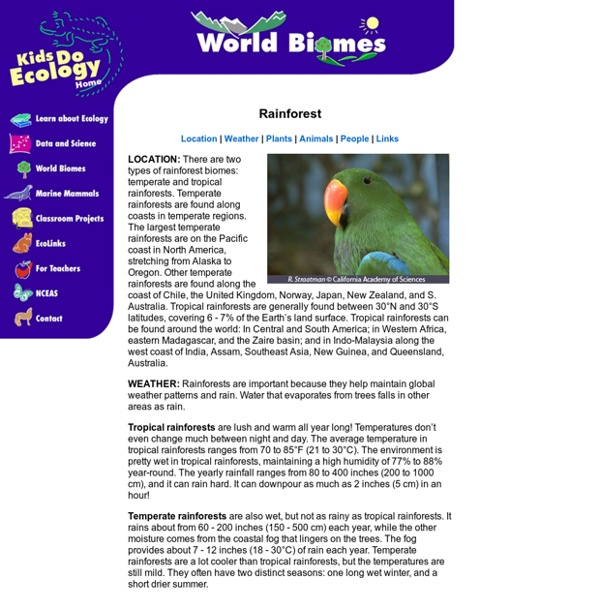Tropical Rainforest
As of July 1, 2013 ThinkQuest has been discontinued. We would like to thank everyone for being a part of the ThinkQuest global community: Students - For your limitless creativity and innovation, which inspires us all. Teachers - For your passion in guiding students on their quest. Partners - For your unwavering support and evangelism. Parents - For supporting the use of technology not only as an instrument of learning, but as a means of creating knowledge. We encourage everyone to continue to “Think, Create and Collaborate,” unleashing the power of technology to teach, share, and inspire. Best wishes, The Oracle Education Foundation
The average temperature in the rainforest is about 30C, 80F it changer very little through out the year
Tropical Rainforest The rainforest that we have chosen to do our project on is in and is called the Amazon Rainforest. You can see on the picture in the upper left corner that the Amazon is the dark green area on the map. This zone which covers much of the northern half of that is east of the and north of the which centers at the equator. It extends through large parts of . In an average year in a tropical rainforest, the climate is very humid do to all of the rain which amounts to about 250cm per year. The climate is found near the equator. 40o F. This is red fungus (Pycnoporus sanguineus) these would be classified in the Fungi kingdom. This is white fungus (Lentinus) and it would be classified in the Fungi kingdom. This is the fern leaf. This is the Cattleya Plant. This is the Toco Toucan. This is the vampire bat. This is Euglena. This is an Actinopod. Howler Monkey The howler monkey is the loudest monkey in the rainforest. The howler monkey can get up to 2ft and there tail 30”. 1. 2.
Science for Kids: Tropical Rainforest Biome
One of the most fascinating biomes on planet Earth is the tropical rainforest. It is filled with tall trees, interesting plants, giant insects, and all sorts of animals. What makes a forest a rainforest? As you might have guessed from the name, rainforests are forests that get a lot of rain. Tropical rainforests are located in the tropics, near the equator. Most rainforests get at least 75 inches of rain with many getting well over 100 inches in areas. Rainforests are also very humid and warm. Where are the world's rainforests? There are three major areas of tropical rainforests: Africa - The major tropical rainforest in Africa is in the southern central portion of the continent with the Congo River running through it. Biodiversity The tropical rainforest has the most biodiversity of all the land biomes. Layers of the Rainforest The rainforest can be divided up into three layers: the canopy, the understory, and the forest floor. The canopy - This is the top layer of trees.
Tropical Rain Forest
As you can see from the map to the right, the tropical rainforests are, indeed, located in the tropics, a band around the equator from 23.5 N (the Tropic of Cancer) to 23.5 S (the Tropic of Capricorn) (red lines on map, right). Because the Earth tilts 23.5 degrees on its axis as it travels around the sun, at some point in the year (the solstices, June 22nd in the north, December 22nd in the south) the sun will be directly overhead on one of these lines. At the equinoxes the sun is directly over the equator. Within this band, solar radiation is most intense, and thus the surface of the planet warms the most. Not all of the land in the tropics is tropical rainforest. {*style:<a href=''>*}{*style:</a>*}Another biome similar to the tropical rain forest is the{*style:<b>*} cloud forest.
Tropical Rainforest
The layers are: Emergent layer Top layer is the emergent layer, the tops of huge trees as big as 100m that rise high above the rest of the forest, therefore receiving the most sunlight. Canopy The second layer the canopy, tall trees growing close together so that their tops are close, forming a fairly continuous cover. Understorey The third layer is the understorey, smaller trees, bushes, and plants such as ferns. Forest floor The fourth layer is the forest floor, where few plants grow because almost no sunlight reaches it. Why do tropical rainforests have so many species of plants and animals? There are billions of species (kinds) of mammals, insects, birds and reptiles found in tropical rainforests, so many that scientists do not yet know all the species, and new ones are still being discovered.
Tropical rainforest climate
Worldwide zones of Tropical rainforest climate (Af). A tropical rainforest climate, also known as an equatorial climate, is a tropical climate usually (but not always) found along the equator. Regions with this climate typically feature tropical rainforests, and it is designated by the Köppen climate classification. Description[edit] Distribution[edit] Upland rainforest in Borneo. A tropical rainforest climate is usually found at latitudes within five degrees North and south of the equator, which are dominated by the Intertropical Convergence Zone. Some of the places that have this climate are indeed uniformly and monotonously wet throughout the year (e.g., the northwest Pacific coast of South and Central America, from Ecuador to Costa Rica, see for instance, Andagoya, Colombia), but in many cases the period of higher sun and longer days is distinctly driest (as at Palembang, Indonesia) or the time of lower sun and shorter days may have more rain (as at Sitiawan, Malaysia). Examples[edit]



